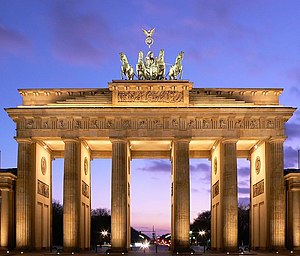This article relies largely or entirely on a single source. (November 2023) |
The Brandenburg Gate (German: Brandenburger Tor) is the only remaining town gate in Berlin, Germany. It was built between 1788 and 1791.[1]

According to the official website of the City of Berlin: "The Brandenburg Gate is Berlin's most famous landmark ... A symbol of German division during the Cold War, it is now a national symbol of peace and unity."[2]
Location
changeThe Brandenburg Gate is located between the Platz des 18. März and the Pariser Platz. Nearby to the north is the Reichstag building. During the Cold War, the Reichstag was in West Berlin, and the Brandenburger Tor in East Berlin.
Structure
changeThe Brandenburg Gate has twelve columns: six on the entrance side and six on the exit. The columns form five roadways. Originally, citizens were allowed to use only the outer two, while the central roadway was reserved for royal officials.[1] Admiralty Arch in London is similar.
The Quadriga
changeIn 1793, Johann Gottfried Schadow placed a bronze sculpture called the Quadriga on top of the gate.[2] It depicts Victoria, the Roman goddess of victory, carrying a peace symbol and driving a horse-drawn chariot (called a quadriga). The sculpture was meant to symbolize peace entering the city.[2]
History
changeNapoleon's era
changeIn 1806, during the First French Empire, Napoleon's army defeated Prussia at the Battle of Jena-Auerstedt. After the victory, Napoleon stole the Quadriga and took it to Paris.
When Prussian forces defeated Napoleon in 1814, Prussian General Ernst von Pfuel occupied Paris and took the Quadriga back to Berlin. The sculpture's olive wreath was changed to an Iron Cross, and the Goddess Viktoria became Nike, the goddess of victory.
During World War II
changeWhen the Nazis came to power, they used the Brandenburg Gate as a symbol. They included the symbol in a lot of their propaganda.
Allied bombings targeted the Brandenburg Gate because it was a highly visible and important symbol of Nazi power.[3] It was badly damaged, but not destroyed. After the war, it was restored by the governments of East Berlin and West Berlin.
The Berlin Wall
changeWhen the Berlin Wall was built in 1961, the Brandenburg Gate was closed because it was in the middle of the death strip.
In 1963, when U.S. President John F. Kennedy visited it, the Soviets hung large banners across the gate to prevent him from seeing into East Germany.
In the 1980s West Berlin mayor Richard von Weizsäcker said:
The German question will remain open as long as the Brandenburg Gate is closed.
In 1987, U.S. President Ronald Reagan gave his famous speech "Tear down this wall!" outside of the gate.[4]
After the Berlin Wall
changeIn 1989, the Berlin Wall was torn down. West and East Germany were reunified the following year under President Richard von Weizsäcker.
On the 22nd of December 1989, West German Chancellor Helmut Kohl walked to the Brandenburg Gate to be greeted by East German Prime Minister Hans Modrow, officially reopening the gate and the pathway between East and West Germany.[1] After that, the Brandenburg Gate symbolized the freedom to unite the City of Berlin.
Between 2000 and 2002, the Brandenburg Gate was privately refurbished.[1]
Photo gallery
change-
Napoleon entering Berlin through the Gate
-
The Brandenburg Gate in 1871
-
The Brandenburg Gate in 1982 seen from the East Berlin side. Behind the gate is the Berlin Wall. In front is the rail that was accessible from East Berlin.
-
United States President Ronald Reagan giving a speech on June 12, 1987
-
The Quadriga atop the Brandenbrug Gate (August 2003)
-
Brandeburg Gate (May 2015)
References
change- ↑ 1.0 1.1 1.2 1.3 "Brandenburg Gate | Iconic Monument, Berlin, Germany | Britannica". www.britannica.com. 2024-07-26. Retrieved 2024-09-13.
- ↑ 2.0 2.1 2.2 City of Berlin (24 February 2023). "Brandenburg Gate". Berlin.de: The Official Website of the City of Berlin.
- ↑ "Brandenburg Gate: A National Icon". CyArk. 2024. Retrieved 2024-09-13.
- ↑ "President Ronald Reagan: Speech at the Brandenburg Gate". www.au.af.mil. United States Air Force. 12 June 1987. Archived from the original on 17 July 2019. Retrieved 6 September 2016.
Other websites
change- Brandenburg Gate Website
- Street map of the Brandenburg Gate's location Archived 2022-04-24 at the Wayback Machine – GlobalGuide
- Brandenburg Gate described in its historic context Archived 2004-04-07 at the Wayback Machine
- Panorama Brandenburg Gate - Panoramic view from the Pariser Platz
- Webcam: Live-View of the Street "Unter den Linden" with Brandenburg Gate in Berlin, Germany
- Germany, Berlin, Brandenburger Tor Virtual tour with map and compass effect by Tolomeus
- Panorama Brandenburg Gate 1945 Archived 2023-06-05 at the Wayback Machine - Panoramic view into the past, 60 years after WWII
52°30′59″N 13°22′40″E / 52.5163°N 13.3777°E